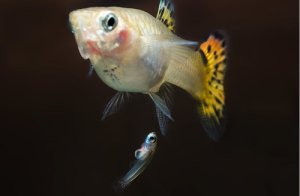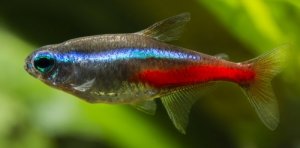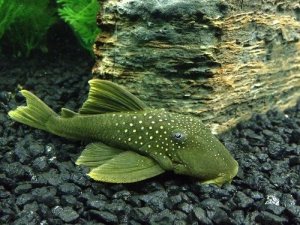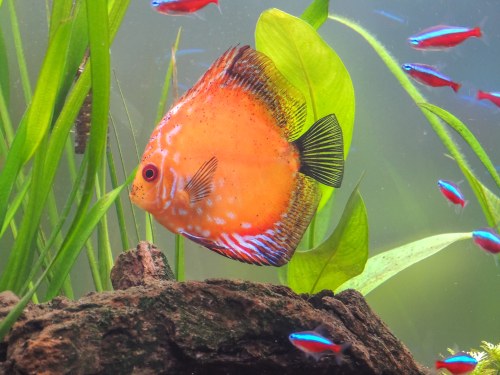
Discus fish are a sight to behold. These little kings of tropical fish species are pretty shy but social among their own kind. As a discus fish owner, you will spend time with one of the best-looking types of aquarium fish, so your environment is bound to look stunning.
Their patterns are unique and come in a broad spectrum of colors. While they are gorgeous, there’s a factor worth considering when caring for these cichlids. At the top of this list is their specialized needs.
These aquatic creatures can develop some pretty grim symptoms that may become challenging to address. But, if you’re a discus fish owner and you’re wondering why your discus is not eating, you’re in the right place. This article covers some of the most identifiable reasons behind a discus fish’s lack of appetite.
Why Your Discus Fish Is Not Eating
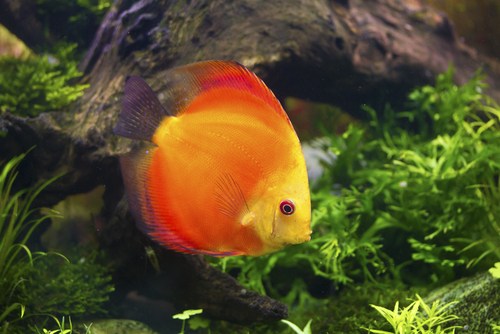
A plethora of factors can affect your discus fish not eating and appearing uninterested in a tasty meal. Their diet is quite diverse as they are omnivores that are able to enjoy everything from plant material to worms and little crustaceans in the tank.
If yours doesn’t seem to show any interest in the sort of food you have for it, you might want to see if this relates to any of the reasons we’ve got here.
1. New Discus Fish Added To Your Aquarium
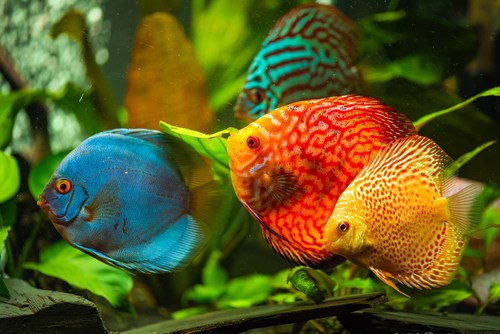
Although discus are social, they also tend to have their own distinct personalities. When a new discus is added to a tank, it might take some time for them to acclimate to the new environment. This period could last between a few hours or even a few weeks.
Typically, most new discus fish are able to adapt to a new environment within 2-5 days. Not adapting to the environment may be one of the causes of discus fish illness.
How To Get A New Discus Fish To Eat
- Patience: Some patience is valuable during this time. While it may eat once in a while, the feeding habits of a new discus are not precisely consistent. It’s nothing that you should be too worried about. Once it gets used to the place, it should be able to show this by floating toward the front of your tank as a gesture to ask for food. At this point, it’s OK to celebrate its good health!
- Change Food: If you feel it’s taking too long for your discus to settle into the aquarium, it might be time to change its feed and see if things change. Discus fish are not picky eaters, so you can experiment with little fish flakes and other food lying around.
- Try Live Foods: A surefire way to see if it’s a palette problem is to try feeding the discus fish some live foods. For example, bloodworms should be something that your fish will dive into munching. They are nutritious and provide enough valuable nutrition while being easy on their stomachs. Persuading a discus fish to eat can also be aided with the help of garlic, according to many discus owners. Also, if food has been left uneaten, be sure to remove it within two days to ensure that bacteria doesn’t develop in your tank from the rot.
2. Low Water Temperature
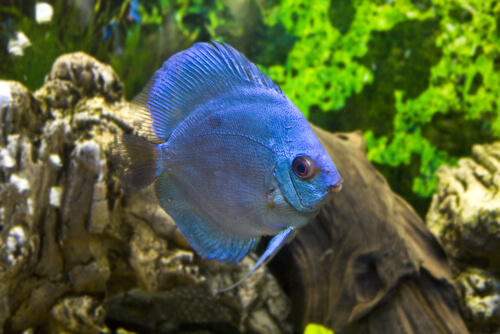
Discus are pretty keen on warm temperatures, so you’ll need to own a heater if you’re taking care of these exotic creatures.
When the temperature in your home drops or your heater stops working, a discus fish may begin to experience loss of appetite. Yes, it’s a bit odd for them to operate in this way, but it’s best to avoid attempting to force them to adjust to unnatural temperatures as this is one of the causes of discus fish death.
How To Achieve The Right Temperature For A Discus
When the temperature is optimum, you won’t be asking, ‘why is my discus fish not eating? ‘They will eat comfortably with no effort. Install a thermometer in your tank to be on the safe side with your fish.
- Correct Temperature: For the water temperature to be perfect, you should ensure it is not below 80-86 degrees Fahrenheit. If you have plants inhabiting your aquarium, you should keep the 80 degrees Fahrenheit baseline. Without any plants in the tank, 86 degrees Fahrenheit serves as the perfect environment for a discus.
- Higher Doesn’t Mean Better: While they may enjoy warmer temperatures, it’s important to remember that your discus can experience complications if the temperature is too high. For example, when the temperature of your tank is above 86 degrees for too long, your discus can begin to suffocate. This puts your pet at risk of sustaining permanent damage and being the leading causes of discus fish death. As long as you use a good thermometer, it should be easy to manage the temperature. Once the temperature is correct, your discus should begin eating without any complications.
3. Water Quality
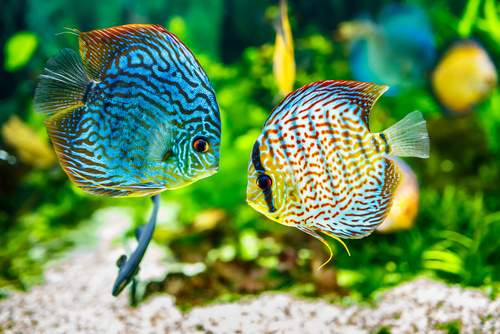
If your discus fish isn’t eating, one of the first things worth looking at is the water. Water quality is an integral part of survival for aquarium fish, and among these types of fish, discus’ are most particular about the quality they need to thrive. One thing they have a big problem with is an environment with high ammonia levels.
How To Maintain The Best Water Quality For Your Discus
- pH level: Thankfully, the fix for this is not complicated, and a quick change in the water should work as an easy solution. Things may get a bit more technical in terms of what the actual water parameters should be. First, you’ll need to learn the best pH and temperature levels for your tank size. A pH of 6.0 – 7.0 is also ideal for caring for most aquarium fish.
- Water Changes: Ensure that you’re able to do regular tank water changes. A good benchmark should be around 25% of the water is changed weekly. If all these factors are not in line, your discus will likely stop eating due to the stress they might be enduring.
- Tank Size: Ideally, your discus fish should be housed in a tank with a water capacity of at least 200 liters. If you’re using a tank smaller than that, you may risk developing growth complications that can stress out your discus. They tend to grow up to be between 20 and 25 cm long.
4. Fish Tuberculosis
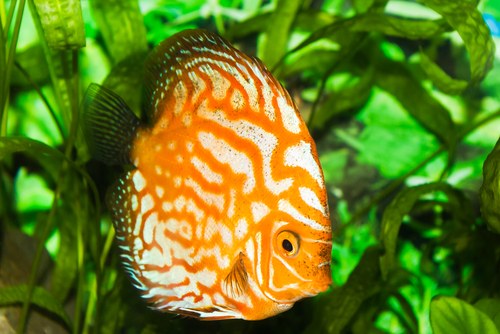
One of the more serious reasons why your fish is not eating is due to fish tuberculosis. When your fish has tuberculosis, loss of appetite is one of the most significant tell-tale signs. Some other symptoms are lethargy, bloating, unusual curvatures in the spine, jerky movements while swimming, and even skin sores.
When skin sores appear, you should be alarmed as this indicates a worsening infection for the discus fish.
How To Treat Fish Tuberculosis In Your Discus
- Early Treatment: Starting treatment as early as possible is the next best solution apart from prevention. However, you’ll need to handle every step with care, as you risk being infected if you have any open cuts or wounds.
- Quarantine Your Discus: When your discus shows signs of this condition, it’s best to move you discus to a quarantine tank. That way, the tuberculosis mycobacteria won’t infect other tankmates. Then, get the proper treatment from an aquatic veterinarian and give your discus time to recover.
- Treatment: Make sure the treatment does not take place in its main tank. Disinfect your tank, and ensure the temperature, pH, and other conditions are ideal. Treating with Kanamycin and Vitamin B-6 for 30 days is a good step for this condition. Add one drop of Vitamin B-6 for every 5 gallons of your aquarium water.
5. Dropsy
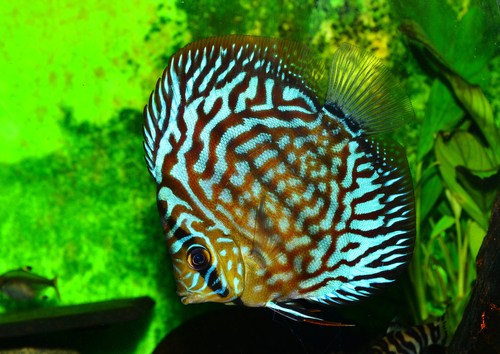
This illness results in some of the more common and unfortunate problems with discus fish. When a discus has dropsy, you can begin to see swelling of the abdomen, blisters, and even bulging eyes.
How To Treat Dropsy In Discus Fish
Thankfully, it’s easy to spot dropsy, but treatment isn’t exactly a simple solution. Instead, it requires quarantine and a few notable steps. It’s especially dangerous, and it is essential to take action once you notice this, as it can affect other fish.
- Causes Of This Illness: Dropsy, in particular, is caused by stress in a fish, especially when a tank is overcrowded. In addition, it can be one of the causes of discus fish death. If it is experiencing extreme symptoms such as not eating, treating the water in your tank with medicine may not cut it.
- Treat For Dropsy: Epsom salt is helpful with relieving bowel problems in your fish. Add 1 or 2 tablespoons of Epsom salt for every 10 gallons of water in your quarantine tank. Lower your pH to 6.0, feed it anti-bacterial fish food, and see if it starts eating. Then, keep observing, consulting with your vet, and adding treatments.
6. Tail Rot Or Fin Rot
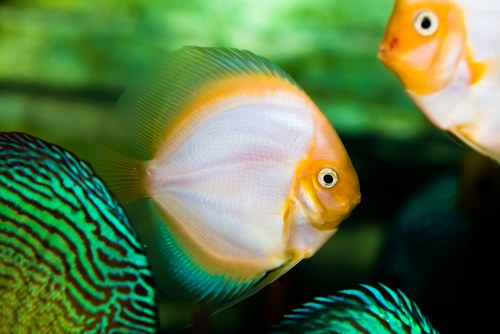
Tail and fin rot in your discus fish is a clear sign of a bacterial infection and can be the reason for discus fish not eating. The rot is presented in the form of a cloudy white appearance as well as fraying on the tail and fins. In particularly awful cases, this fraying leaves red streaks.
How To Treat Fin And Tail Rot In A Discus Fish
- Treat The Infection: Tail or fin rot is treated similarly to most of the other problems faced in discus fish tanks. Changing the water, improving the parameters, and ensuring that your fish is not stressed should work well enough to solve this problem.
- Quarantine: Always remember to quarantine your fish, inspect the tank and clear it out to get things back to a controlled environment.
7. Hexamitiasis
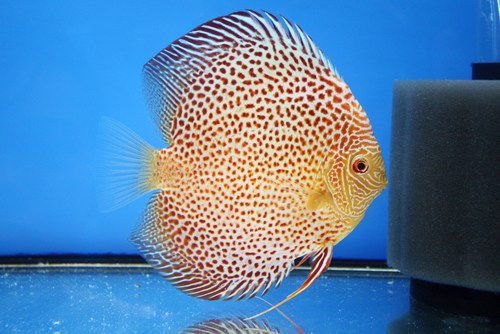
This infection is one that makes a fish visibly different in terms of appearance and behavior. One of the most significant symptoms of the problem is a reduced appetite. Some other symptoms include white feces and even a hole in the head.
Hexamitiasis can be caused by continued stress in a discus, diet, and even contact with a new discus that carries the Hexamita bacteria.
How To Treat Hexamita In A Discus Fish
- Consult An Expert: Improving the water in your tank should be your top priority, but it may not be enough. Consulting an expert is your best bet, as they can accurately recommend medication doses. To treat it, you’ll need Metronidazole, a drug that can improve your pet’s condition.
- Infection Prevention: Once you begin administering treatment, check your aquatic friend’s appetite occasionally for any improvements. To prevent this infection in the future, be sure that your discus has a proper filter in the aquarium. In addition, be cautious when introducing a new discus.
What Is The Best Habitat For Discus Fish?
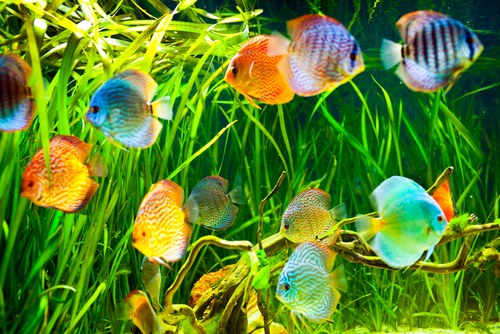
Like many animals, fish tend to adapt according to the environment their parents thrived in. As a discus fish owner, it’s important to keep this in mind. Typically, owning an aquarium comes with general knowledge of how to care for fish. However, certain types of fish, like the discus, may come with their own unique set of requirements worth following.
Discus fish are native to warmer climates like the Amazon River. Therefore, there’s a natural tendency for them to prefer a warmer aquarium. They are incredibly particular with water due to their biology. The detailed water specifications for a discus are worth taking a close look at.
Just by looking at one, it’s fairly evident that discus fish are unlike other fish. Their shape is distinctly unique, and they have a laterally compressed body shape and tiny fins. So they literally look like a discus.
Without the right environment, it might be hard to see why so many aquarium enthusiasts love having discus fish around. They take a special touch and consistency to flourish.
Final Thoughts
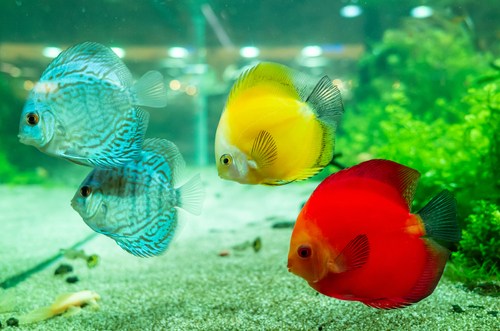
Keeping your Discus fish healthy isn’t the most straightforward task in the world. But, things will get easier with enough consistency and the right tools in your tank. When your discus stops eating, you must observe it to get to the root of the cause. Your pet will thrive once any illness and disease are treated.


